Event Spotlight: Visual Narratives Workshop
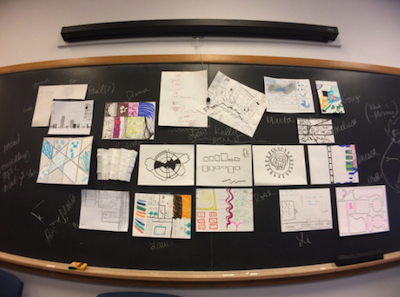
Over three weeks in Summer 2018, Presidential Scholars in Society and Neuroscience Matteo Farinella and Lan Li hosted the Science and Storytelling: Visual Narratives Workshop, which provided participants with the tools and techniques share their research with a broader public audience.
Learn more about their experience below.
Workshop Inspiration
The Science and Storytelling: Visual Narratives Workshop was born out a shared interest in visual communication. Matteo’s work with comics and Lan’s work in film both make extensive use of visual techniques to communicate complex ideas. To engage our audience, we rely on similar strategies, including characters and narratives, maps and metaphors. More importantly, these techniques were independent from our medium of choice and disciplinary field.
It made sense to share these techniques with other scholars. This workshop was an opportunity to directly create a community of researchers from a variety of disciplines. We hoped to facilitate a basic understanding of visual tools, the theories behind them, and how to best reach a broader audience.
Workshop Participants
We were incredibly impressed with the workshop participants. Some of the applicants included practicing psychiatrists, undergraduate biology majors, and graduate students in education, political science, immunology, sociology, journalism, and environmental science.
As it turns out, people who seek out unconventional ways of thinking about their research tend to already have other interests and talents. For instance, one graduate student working on neurorehabilitation and disability was a professionally trained dancer, which he joined with his work in kinesthesiology. Another participant in the Art History department was trained as a health professional and used her artistic skills to make a comic about sexual education for undergraduates at Columbia.
In particular, one participant completely changed his entire attitude towards visual narratives. Trained as a clinical psychiatrist, he initially treated the workshop as a chance to test his theories of visualization rather than communicate what they were in the first place. In other words, he wanted to simply consult and observe. Nevertheless, we invited him to take part in the drawing exercises. At first skeptical, he realized that drawing allowed him to express his ideas differently and with greater clarity. Rather than theorizing about how people process information, he realized that there was a more complex feedback when he produced visual symbols to represent states of mind. Inspired, he returned for the second and third session no longer as an observer, but as an active participant.
By the last session, he worked with Matteo, who challenged him to think of metaphors that could visually represent his theories of mathematical models of visual and emotional processing. The more he talked to Matteo, the more he realized the parts of his theory that did not encompass all of the complexities of visual processing. In other words, he realized the limitations of his own mathematical model. He found the session with Matteo so helpful that he said that he wanted to actively seek out collaborations with artists to visually translate his ideas.
The exercises also changed how one graduate student in psychiatry made use of his data. While storyboarding a video trailer about his research, he realized that it would be visually powerful to show symptoms overlapped in patients who suffered from strokes, multiple sclerosis, Parkinson’s, and other neurodegenerative diseases. Because his research focused on movement therapy, it was important for him to better communicate how his methods of comparing how different diseases with physical manifestations changed over time.
Impact and Feedback
Working with an eclectic group of researchers and scholars was a transformative experience. Our participants brought with them expertise and enthusiasm. Together, we intuitively understood the power of visual communication, but rarely had the chance to reflect on what makes visual communication effective, and closely consider the different processes to create these narratives. Co-designing and co-teaching this workshop enabled us to consider more fundamental questions: what constitutes a good visualization? How can these tools help us communicate across disciplines and to the general public?
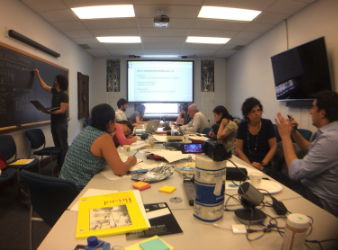
Thanks to support from CSS, we had the chance to work with a motivated group of participants over a prolonged period of time. This allowed us to develop specific visual strategies to communicate each participant’s research and go beyond theories of data visualization, which exist in abundance with books like those by Edward Tufte. These kinds of close collaborations could not be done during a regular seminar or a shorter workshop. Together, we created an informal space where people felt comfortable to challenge themselves, test new tools/techniques and receive feedback from people working in other fields.
The greatest impact that our participants described was the chance to connect with people from other disciplines and the potential for new collaborations. One participant wrote:
The diversity of the participants was fantastic! I have learned a lot from several other participants. The instructors were very good and attentive. Both presentations and small group/one-on-one interactions were very helpful and brought new insights to my work.
In terms of the specific goals of the workshop, a majority of respondents also reported learning new skills, which “sprouted new ideas for how I present my own work going forward” and “helped me think about my process of organization of ideas and how I deliver them.”
Even with this positive feedback, we found that one of the main challenges was to accommodate different backgrounds, interests, and levels of familiarity with visual communication. Some participants had never thought much about visualization so they were mostly interested into a general introduction to the field, while others were already confident with visual communication and would have preferred to have more time to experiment and develop their own personal project. During the selection process, we asked participants to think of a specific concept from their own field that they may want to illustrate, but three sessions proved insufficient to produce a finished product.
Our participants were significantly satisfied with the workshop instructors, materials, and outcomes (see table). If anything, their main comment feedback was that they wished that they had more sessions and that the three meetings over three weeks was barely enough.
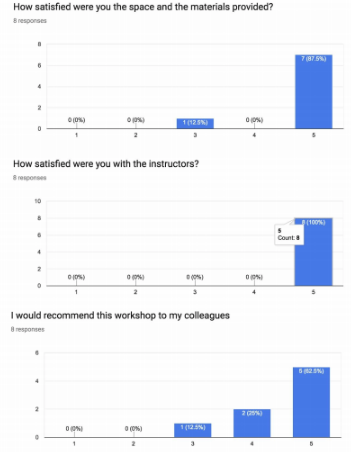
Several participants suggested that the workshop should have been longer, possibly with monthly meetings over a whole semester, to give people the time to both absorb the theory and start working on a long-term project. One participant even suggested to create “follow up office hours, where participants can continue to work on projects and get individual feedback.”
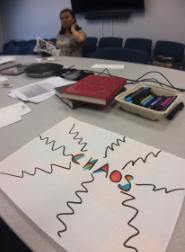
Overall, we consider this first experience very positive. This workshop has even impacted our own research. For instance, Lan has used the visual exercises for a video series on Metaphors of the Mind, which is a new collaboration with neuroscientists, psychiatrists, historians of science, and literary scholars. With the amount of feedback from our participants, we are planning a follow-up meeting at the end of the summer and potentially a second workshop in the Spring.
The general enthusiasm suggests that there is considerable interest in visual communication and not enough opportunities for scholars to acquire these skills. Now that we know we can count on engaged participants we would certainly consider running a longer more in depth workshop, which will be again more broadly open to a range of disciplines within the Columbia community and beyond.
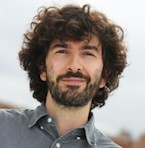
Matteo Farinella received a PhD in neuroscience from University College London in 2013. As a Presidental Scholar (2016-2019), Matteo investigates the role of ‘visual narratives’ in science communication. Working with science journalists, educators, and cognitive neuroscientists, he aims to understand how these tools may affect the public perception of science and increase scientific literacy.
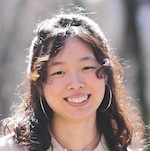
Lan A Li is a historian of the body and filmmaker. She received her PhD in Science, Technology, and Society Studies at MIT in 2016. As a Presidental Scholar (2016-2019), Lan focuses on developing a comparative history of numbness. She is particularly interested in how representations of peripheral sensation through hand-drawn maps cohered and conflicted with different perceptions of health and disease.
Interested in supporting our work at the intersection of science and society? Visit our donation page or feel free to contact us.
